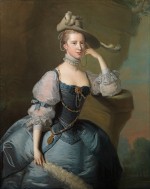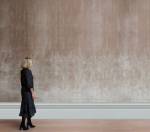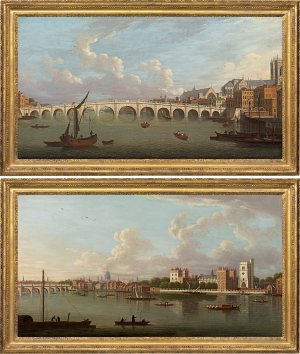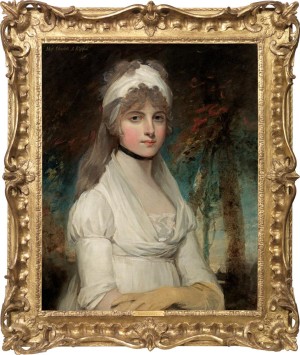Thomas Hudson
Portrait of Catherine 'Kitty' Jervis (1733 - 1756), Mrs Jeremiah Smith
Oil on canvas: 50 x 40 (in) / 127 x 101.6 (cm)
This artwork is for sale.
Please contact us on: +44 (0)20 7493 3939.
Email us
THOMAS HUDSON
Devon 1701 - 1779 Twickenham
Ref: BZ 136
Portrait of Catherine ‘Kitty’ Jervis (1733-1756), Mrs Jeremiah Smith
Oil on canvas: 50 x 40 in / 127 x 101.6 cm
Frame size: 48 x 58 in / 121.9 x 147.3 cm
In a period eighteenth century swept and pierced, carved and gilded frame
Painted circa 1755
Provenance:
The sitter’s brother, Admiral of the Fleet John Jervis, 1st Earl of St Vincent (1735-1823), Meaford Hall, Staffordshire;
removed from Meaford Hall when the house was sold in 1943;
by descent to Edward Swynfen Parker-Jervis
Exhibited:
Birmingham, City Museum and Art Gallery, Exhibition of Treasures from Midland Homes, 2nd November-2nd December 1938 (lent by Mr Robert St Vincent Parker-Jervis)
Devon-born, like his famous pupil Sir Joshua Reynolds, Thomas Hudson was one of the most fashionable portrait painters in London by the 1740s. He bought himself an impressive house in Great Queen Street, painted such worthies as the Duke of Cumberland and George Frederic Handel, and campaigned to raise the status of artists as a member of the St Martin’s Lane group. Hudson visited France and the Netherlands with his friend William Hogarth in 1748, exposing him to the sensuous handling of Flemish painting, as well as elements of the French rococo.
Catherine Margaret Jervis, known to her family as Kitty, was the second daughter of Swynfen Jervis (1700-1771) of Meaford Hall, near Stone, Staffordshire and his wife Elizabeth Parker, daughter of George Parker of Park Hall. Both of Kitty’s parents came from long-established Staffordshire gentry families; the Jervises had been established in the county since the days of Edward III (reg. 1327-77). Swynfen Jervis practised as a lawyer, becoming Counsel to the Admiralty and Auditor to Greenwich Hospital; the family divided their time between Greenwich and their estates.
On 18th March 1755 Kitty married at St Alphege, Greenwich a Staffordshire neighbour, Jeremiah Smith of Great Fenton Hall, which was situated eight miles north of Meaford. This portrait was probably made around the time of her marriage. Thomas Hudson was clearly the portraitist of choice for the family: he painted Jeremiah Smith, by then High Sheriff of Staffordshire, in 1762 (Staffordshire County Buildings, Stafford). The Smiths were prominent landowners in Great Fenton, today a suburb of Stoke-on-Trent. By the mid-eighteenth century the area was becoming part of the heartland of the Industrial Revolution, with ceramic producers that would later bear famous names such as Spode, Copeland and Minton. The country was rich in ironstone and coal, essential for the firing of the kilns. Jeremiah Smith obtained mining rights in Fenton which were developed by his descendants. By 1840, a land ‘once the pure and peaceful domicile of [the owners’] ancestry [was] but now the black and noisy seat of Cyclopean labours’.
Naturally, no hint of this gradual industrialisation is apparent in Hudon’s portrait of Kitty Jervis. She is portrayed leaning against a rock with a woodland sunrise beyond. Her elegant, broad-brimmed hat, which gives her a dashing air, puffed sleeves and the feather in her hand are inspired by a Rubens portrait then thought to be of his wife, but which probably depicts his sister-in-law, Susanna Fourment (Gulbenkian Museum, Lisbon). It was acquired by Sir Robert Walpole and hung in the Van Dyck Drawing Room at Houghton, but was well known from James McArdell’s mezzotint after it. The Rubens portrait sparked a vogue for painting ladies in ‘van Dyck’ dress, much employed by Hudson in the 1730s and 40s, as well as the use of van Dyck dress in masquerade costumes. Horace Walpole wrote to his friend Horace Mann in 1742 of seeing at the Duchess of Norfolk’s masquerade ‘quantities of pretty Vandykes, and all kinds of old pictures walked out of their frames’[1].
Kitty’s costume is a charming fantasy, a hybrid of ‘van Dyck’ dress and mid-eighteenth century high fashion. The lace choker at her throat is in contemporary vogue, as is her jewellery. A locket probably containing a likeness of her husband is strung from the rubies and pearls at her waist. Hudson repeated this model, down to the rocky background and soft blue silk dress, in a full-length portrait of Mary Bertie, Duchess of Ancaster and Kesteven, painted in 1757 (Grimsthorpe Castle, Lincolnshire). The same format is employed in a portrait of Lady Oxenden (Art Gallery of New South Wales), recently reattributed to Hudson’s pupil Joseph Wright of Derby.
Sadly, Kitty’s marriage was short-lived: she died giving birth to her son Charles in 1756. Her portrait was inherited by her younger brother John Jervis (1735-1823), whose brilliant naval career led to his creation as 1st Earl of St Vincent for his victory over the French at Cape St Vincent on 14th February 1797, an action which also brought Captain Horatio Nelson to prominence. A just, well-loved and reforming officer, Jervis crowned his career as Admiral of the Fleet. Kitty’s painting remained at Meaford Hall until the house was sold in 1943 and has descended in the Parker-Jervis family.
Susan Morris
Thomas Hudson, Mary Bertie, Duchess of Ancaster and Kesteven, 1757.
Grimsthorpe Castle, Lincolnshire.
Thomas Hudson, Jeremiah Smith of Great Fenton, High Sheriff of Staffordshire, 1762.
Oil on canvas: 49 x 39 ½ in / 124.5 x 100 cm
Staffordshire County Buildings, Stafford/Art UK.
THOMAS HUDSON
Devon 1701 - 1779 Twickenham
Born in Devon of tradesman stock, Thomas Hudson was apprenticed to the London portrait painter Jonathan Richardson, whose daughter he had married by 1725. Hudson inherited Richardson's conservative, crisp style and in 1740, upon the older man's retirement, many of his clients.
From 1733-39 Hudson divided his time between London, the West Country and portrait commissions elsewhere in England. In 1739-40 he painted the 29 members of Barnstaple town corporation. The 1742 departure of the fashionable French portrait painter Jean-Baptiste van Loo left the field clear for Hudson to become the most sought-after portrait painter of his day, inhabiting an impressive Great Queen Street house and portraying such worthies as the Duke of Cumberland and George Frideric Handel (1747-8). He modified his severe style with rococo influence and baroque elements taken from the portraits of van Dyck and Rubens, whose drawings he collected. Hudson was part of the St Martin’s Lane group of artists who lobbied for greater status for their profession, and he was also a Governor of the Foundling Hospital. His pupils included Joseph Wright of Derby, Joshua Reynolds and John Hamilton Mortimer.
In 1748 Hudson visited France and the Netherlands with his drapery painters Joseph and Alexander van Aken, and William Hogarth (who was caught sketching in Paris and put in the Bastille for ‘spying’). In 1752 Hudson visited Rome with the sculptor Louis-François Roubiliac. In the 1750s Hudson’s portrait style became looser and richer in tone. In this decade he painted several very fine group portraits, for example The Courtenay family (Powderham Castle). In 1755 Hudson acquired a villa on the Thames at Twickenham, which he filled with his extensive art collection. From 1761 he was semi-retired, ceasing to paint in 1767. In 1770 he married a wealthy widow, Mary Fynes, and died at Twickenham in 1779.
The work of Thomas Hudson is represented in the British Royal Collection; Tate Britain, London; the National Portrait Gallery, London and many English country house collections.
[1] Quoted in London, The Iveagh Bequest, Kenwood, Thomas Hudson 1701-1779, 1979, exh. cat. by Ellen Miles, under no.15.








